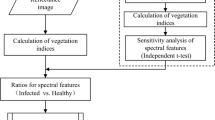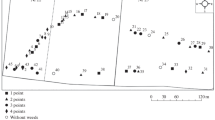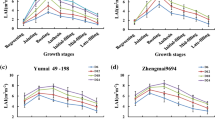Abstract
In this study, we investigated the possibility of using ground-based remote sensing technology to estimate powdery mildew disease severity in winter wheat. Using artificially inoculated fields, potted plants, and disease nursery tests, we measured the powdery mildew canopy spectra of varieties of wheat at different levels of incidence and growth stages to investigate the disease severity. The results showed that the powdery mildew sensitive bands were between 580 and 710 nm. The best two-band vegetation index that correlated with wheat powdery mildew between 400 and 1000 nm wavelength were the normalized spectrum 570–590 and 536–566 nm bands for the ratio index, and 568–592 and 528–570 nm for the normalized difference index. The coefficients of determination (R 2) for both were almost the same. The optimum dual-green vegetation index was constructed based on a calculation of the ratio and normalized difference between the normalized spectrum within the two green bands. The coefficients of determination (R 2) of DGSR (584, 550) (dual-green simple ratio) and DGND (584, 550) (dual-green normalized difference) were both 0.845. The inverse models of disease severity performed well in the test process at the canopy scale, and indicated that, compared with the traditional vegetation indices of Lwidth, mND705, ND (SDr, SDb), SIPI, and GNDVI, the novel dual-green indices greatly improved the remote sensing detection of wheat powdery mildew disease. Following these results, combined disease severity and canopy spectra were shown to be of enormous value when applied to the accurate monitoring, prevention, and control of crop diseases.






Similar content being viewed by others
Abbreviations
- SR:
-
Simple ratio
- ND:
-
Normalized difference
- SD:
-
Simple difference
- MSR:
-
Modified simple ratio
- SIPI:
-
Structural independent pigment index
- SAVI:
-
Soil adjusted vegetation index
- TSAVI:
-
Transformed soil adjusted vegetation index
- MSAVI:
-
Improved SAVI with self-adjustment factor L
- PSRI:
-
Plant senescence reflectance index
- CTR2:
-
Carter indices
- mND705:
-
Modified ND705 by incorporating reflectance at 445 nm
- Depth672:
-
The depth of the absorption feature at 672 nm
- Lwidth:
-
Red edge width
- SDr:
-
Sum of 1st derivative values within red edge
- SDb:
-
Sum of 1st derivative values within blue edge
- SDy:
-
Sum of 1st derivative values within yellow edge
- ND (SDr, SDb):
-
Normalized difference between SDr and SDb
- ND (SDr, SDy):
-
Normalized difference between SDr and SDy
- PRI:
-
Photochemical reflectance index
- RVI:
-
Ratio vegetation index
- NDVI:
-
Normalized difference vegetation index
- GNDVI:
-
Green normalized difference vegetation index
- RVSI:
-
Red-edge vegetation stress index
- VARI:
-
Visible atmospherically resistant index
- WI:
-
Water index
- NSRI:
-
Spectral ratio index in near-infrared shoulder region
- PMI:
-
Powdery mildew index
- MCARI:
-
Modified chlorophyll absorption ratio index
- ARI:
-
Anthocyanin reflectance index
- DGND:
-
Dual-green normalized difference
- DGSR:
-
Dual-green simple ratio
- RGND:
-
Red-green normalized difference
- RRSD:
-
Red-red simple difference
- ReRSD:
-
Red-edge-red simple difference
- PLSR:
-
Partial least squares regression
- cDI:
-
Conventional disease index
- mDI:
-
Modified disease index
- LAI:
-
Leaf area index
- R2 :
-
The coefficients of determination
- RMSE:
-
The root mean square error
- RE:
-
The relative error
References
Atzberger, C., Darvishzadeh, R., Immitzer, M., Schlerf, M., Skidmore, A., & Maire, G. (2015). Comparative analysis of different retrieval methods for mapping grassland leaf area index using airborne imaging spectroscopy. International Journal of Applied Earth Observation and Geoinformation, 43, 19–31.
Baret, F., & Guyot, G. (1991). Potentials and limits of vegetation indices for LAI and APAR assessment. Remote Sensing of Environment, 35(2–3), 161–173.
Baret, F., Guyot, G., & Major, D. J. (1989). TSAVI: A vegetation index which minimizes soil brightness effects on LAI and APAR estimation. In: Proceedings of IGARRS’89. 12th Canadian symposium on remote sensing, Vancouver, Canada, 3, (pp. 1355–1358).
Cai, C. J., Ma, Z. H., Wang, H. G., Zhang, Y. P., & Huang, W. J. (2007). Comparison research of hyperspectral properties between near-ground and high altitude of wheat strip rust. Acta Phytopathologica Sinica, 37, 77–82. (in Chinese).
Cao, X. R., Luo, Y., Zhou, Y. L., Duan, X. Y., & Cheng, D. F. (2013). Detection of powdery mildew in two winter wheat cultivars using canopy hyperspectral reflectance. Crop Protection, 45, 124–131.
Carter, G. A., & Miller, R. L. (1994). Early detection of plant stress by digital imaging within narrow stress sensitive wavebands. Remote Sensing of Environment, 50, 295–302.
Cheng, T., Rivard, B., Sánchez-Azofeifa, G., Feng, J., & Calvo-Polanco, M. (2010). Continuous wavelet analysis for the detection of green attack damage due to mountain pine beetle infestation. Remote Sensing of Environment, 114, 899–910.
Daughtry, C. S., Walthall, C. L., Kim, M. S., de Colstoun, E. B., & McMurtrey, J. E. (2000). Estimating corn leaf chlorophyll concentration from leaf and canopy reflectance. Remote Sensing of Environment, 74(2), 229–239.
Franke, J., & Menz, G. (2007). Multi-temporal wheat disease detection by multi-spectral remote sensing. Precision Agriculture, 8, 161–172.
Gamon, J. A., Penuelas, J., & Field, C. B. (1992). A narrow-waveband spectral index that tracks diurnal changes in photosynthetic efficiency. Remote Sensing of Environment, 41, 35–44.
Gitelson, A. A., Kaufman, Y. J., & Merzlyak, M. N. (1996). Use of a green channel in remote sensing of global vegetation from EOS-MODIS. Remote Sensing of Environment, 58(3), 289–298.
Gitelson, A. A., Kaufman, Y. J., Stark, R., & Rundquist, D. (2002). Novel algorithms for remote estimation of vegetation fraction. Remote Sensing of Environment, 80, 76–87.
Gitelson, A. A., Merzlyak, M. N., & Chivkunova, O. B. (2001). Optical properties and nondestructive estimation of anthocyanin content in plant leaves. Photochemistry and Photobiology, 74(1), 38–45.
Gong, P., Pu, R. L., & Heald, R. C. (2002). Analysis of in situ hyperspectral data for nutrient estimation of giant sequoia. International Journal of Remote Sensing, 23, 1827–1850.
Graeff, S., Link, J., & Claupein, W. (2006). Identification of powdery mildew (Erysiphe graminis sp. tritici) and take-all disease(Gaeumannomyces graminis sp. tritici) in wheat (Triticum aestivum L.) by means of leaf reflectance measurements. Central European Journal of Biology, 1, 275–288.
Guo, J. B., Huang, C., Wang, H. G., Sun, Z. Y., & Ma, Z. H. (2009). Disease index inversion of wheat stripe rust on different wheat varieties with hyperspectral remote sensing. Spectroscopy and Spectral Analysis, 29, 3353–3357. (in Chinese).
Haboudane, D., Miller, J. R., Pattey, E., Zarco-Tejada, P. J., & Strachan, I. (2004). Hyperspectral vegetation indices and novel algorithms for predicting green LAI of crop canopies: modeling and validation in the context of precision agriculture. Remote Sensing of Environmment, 90, 337–352.
Herrmann, I., Pimstein, A., Karnieli, A., Cohen, Y., Alchanatis, V., & Bonfil, D. J. (2011). LAI assessment of wheat and potato crops by VEN mu S and Sentinel-2 bands. Remote Sensing of Environment, 115, 2141–2151.
Huang, W. J., David, W. L., Niu, Z., Zhang, Y. J., Liu, L. Y., & Wang, J. H. (2007). Identification of yellow rust in wheat using in situ spectral reflectance measurements and airborne hyperspectral imaging. Precision Agriculture, 8, 187–197.
Huete, A. R. (1988). A soil adjusted vegetation index (SAVI). Remote Sensing of Environment, 25, 295–309.
Jing, X., Huang, W. J., Wang, J. H., Wang, J. D., & Wang, K. R. (2009). Hyperspectral inversion models on verticillium wilt severity of cotton leaf. Spectroscopy and Spectral Analysis, 29, 3348–3352. (in Chinese).
Kobayashi, T., Kanda, E., Kitada, K., Ishiguro, K., & Torigoe, Y. (2001). Detection of rice panicle blast with multi-spectral radiometer and the potential of using airborne multi-spectral scanner. Phytopathology, 91, 316–323.
Kokaly, R. F., & Clark, R. N. (1999). Spectroscopic determination of leaf biochemistry using band-depth analysis of absorption features and stepwise multiple linear regression. Remote Sensing of Environment, 67, 267–287.
Li, F., Mistele, B., Hu, Y. C., Chen, X. P., & Schmidhalter, U. (2014). Reflectance estimation of canopy nitrogen content in winter wheat using optimised hyperspectral spectral indices and partial least squares regression. European Journal of Agronomy, 52, 198–209.
Liu, L. Y., Huang, W. J., Pu, R. L., & Wang, J. H. (2014). Detection of internal leaf structure deterioration using a new spectral ratio index in the near-infrared shoulder region. Journal of Integrative Agriculture, 13, 760–769.
Luo, J. H., Huang, W. J., Yuan, L., Zhao, C. J., Du, S. Z., Zhang, J. C., et al. (2013). Evaluation of spectral indices and continuous wavelet analysis to quantify aphid infestation in wheat. Precision Agriculture, 14, 151–161.
Mahlein, A. K., Rumpf, T., Welke, P., Dehne, H. W., Plümer, L., Steiner, U., et al. (2013). Development of spectral indices for detecting and identifying plant diseases. Remote Sensing Environment, 128, 21–30.
Maxwell, J. J., Lyerly, J. H., Cowger, C., Marshall, D., Brown-Guedira, G., & Murphy, J. P. (2009). MlAG12: a Triticum timopheevii-derived powdery mildew resistance gene in common wheat on chromosome 7AL. Theoretical and Applied Genetics, 119, 1489–1495.
Merton, R., & Huntington, J. (1999). Early simulation of the ARIES-1 satellite sensor for multi-temporal vegetation research derived from AVIRIS. In Summaries of the Eight JPL Airborne Earth Science Workshop. JPL Publication, Pasadena, CA (pp. 299–307)
Merzlyak, M. N., Gitelson, A. A., Chivkunova, O. B., & Rakitin, V. Y. (1999). Non-destructive optical detection of pigment changes during leaf senescence and fruit ripening. Plant Physiology, 106, 135–141.
Miller, J. R., Hare, E. W., & Wu, J. (1990). Quantitative characterization of the vegetation red edge reflectance: 1. An inverted-Gaussian reflectance model. International Journal of Remote Sensing, 11, 1755–1773.
Oumar, Z., Mutanga, O., & Ismail, R. (2013). Predicting Thaumastocoris peregrinus damage using narrow band normalized indices and hyperspectral indices using field spectra resampled to the Hyperion sensor. International Journal of Applied Earth Observation Geoinformation, 21, 113–121.
Naidu, R. A., Perry, E. M., Pierce, F. J., & Mekuria, T. (2009). The potential of spectral reflectance technique for the detection of Grapevine leafroll-associated virus-3 in two red-berried wine grape cultivars. Computers and Electronics in Agriculture, 66(1), 38–45.
Peñuelas, J., Baret, F., & Filella, I. (1995). Semi-empirical indices to assess carotenoids/chlorophyll a ratio from leaf spectral reflectance. Photosynthetica, 31, 221–230.
Peñuelas, J., Pinol, J., Ogaya, R., & Filella, I. (1997). Estimation of plantwater concentration by the reflectance water index wi (r900/r970). International Journal of Remote Sensing, 18, 2869–2875.
Qi, J., Chehbouni, A., Huete, A. R., Kerr, Y. H., & Sorooshian, S. (1994). Modified soil adjusted vegetation index (MSAVI). Remote Sensing of Environment, 48, 119–126.
Raikes, C., & Burpee, L. (1998). Use of multispectral radiometry for assessment of rhizoctonia blight in creeping bentgrass. Phytopathology, 88, 446–449.
Sankaran, S., Mishra, A., Ehsani, R., & Davis, C. (2010). A review of advanced techniques for detecting plant diseases. Computers and Electronics in Agriculture, 72, 1–13.
Sharma, A. K., Sharma, R. K., & Srinivasa Babu, K. (2004). Effect of planting options and irrigation schedules on development of powdery mildew and yield of wheat in the North Western plains of India. Crop Protection, 23, 249–253.
Sims, D. A., & Gamon, J. A. (2002). Relationships between leaf pigment content and spectral reflectance across a wide range of species, leaf structures and developmental stages. Remote Sensing of Environment, 81, 337–354.
Steddom, K., Heidel, G., Jones, D., & Rush, C. M. (2003). Remote detection of rhizomania in sugar beets. Phytopathology, 93(6), 720–726.
Tian, Y. C., Yao, X., Yang, J., Cao, W. X., Hannaway, D. B., & Zhu, Y. (2011). Assessing newly developed and published vegetation indices for estimating rice leaf nitrogen concentration with ground- and space-based hyperspectral reflectance. Field Crop Research, 120, 299–310.
Turton, B. C. H. (1992). A novel variant of the Savitzky-Golay filter for spectroscopic applications. Measurement Science and Technology, 3, 858–863.
Wang, D. H., Dowell, F. E., Lan, Y. F., Pasikatan, M., & Maghirang, E. (2002). Determining pecky rice kernels using visible and near-infrared spectroscopy. International Journal of Food Properties, 5, 629–639.
West, J. S., Bravo, C., Oberti, R., Lemaire, D., Moushou, D., & McCartney, H. A. (2003). The potential of optical canopy measurement for targeted control of field crop diseases. Annual review of Phytopathology, 41, 593–614.
Yang, C. M., Cheng, C. H., & Chen, R. K. (2007). Changes in spectral characteristics of rice canopy infest with brown planthopper and lesffolder. Crop Science, 47(1), 329–335.
Yang, Z., Rao, M. N., Elliott, N. C., Kindler, S. D., & Popham, T. W. (2009). Differentiating stress induced by greenbugs and Russian wheat aphids in wheat using remote sensing. Computers and Electronics in Agriculture, 67, 64–70.
Yoshio, I., Eiji, S., Zhu, Y., & Wataru, T. (2012). Diagnositic mapping of canopy nitrogen content in rice based on hyperspectral measurements. Remote Sensing of Environment, 126, 210–221.
Zhang, J., Pu, R., Huang, W., Lin, Y., Luo, J., & Wang, J. (2012a). Using in situ hyperspectral data for detecting and discriminating yellow rust disease from nutrient stresses. Field Crops Research, 134(3), 165–174.
Zhang, J. C., Pu, R. L., Wang, J. H., Huang, W. J., Yuan, L., & Luo, J. H. (2012b). Detecting powdery mildew of winter wheat using leaf level hyperspectral measurements. Computers and Electronics in Agriculture, 85, 13–23.
Zhang, J. C., Pu, R. L., Yuan, L., Wang, J. H., Huang, W. J., & Yang, G. J. (2014). Monitoring powdery mildew of winter wheat by using moderate resolution multi-temporal satellite imagery. PLoS ONE, 9, 93–107.
Zhang, M. H., Qin, Z. H., Liu, X., & Ustin, S. L. (2003). Detection of stress in tomatoes induced by late blight disease in California, USA, using hyperspectral remote sensing. International Journal of Applied Earth Observation and Geoinformation, 4, 295–310.
Acknowledgments
This research was supported by grants from the National Natural Science Foundation of China (30900867), the Special Fund for Agro-scientific Research in the Public Interest (201203096, 201303109), the Twelfth Five-Year National Science & Technology Pillar Program (2015BAD26B01, 2013BAD07B07), and the Key Scientific Research Project of Colleges and Universities in Henan Province, China (15A210010).
Author contributions
Wei Feng, Wenying Shen, Tiancai Guo conceived and designed the research. Wei Feng, Wenying Shen, Yingxue Li and Chenyang Wang analyzed the data and wrote the manuscript. Jianzhao Duan, Li He and Binbin Guo provided data and data acquisition capacity.
Author information
Authors and Affiliations
Corresponding authors
Ethics declarations
Conflict of Interest
The authors declare that they have no conflict of interest.
Rights and permissions
About this article
Cite this article
Feng, W., Shen, W., He, L. et al. Improved remote sensing detection of wheat powdery mildew using dual-green vegetation indices. Precision Agric 17, 608–627 (2016). https://doi.org/10.1007/s11119-016-9440-2
Published:
Issue Date:
DOI: https://doi.org/10.1007/s11119-016-9440-2




